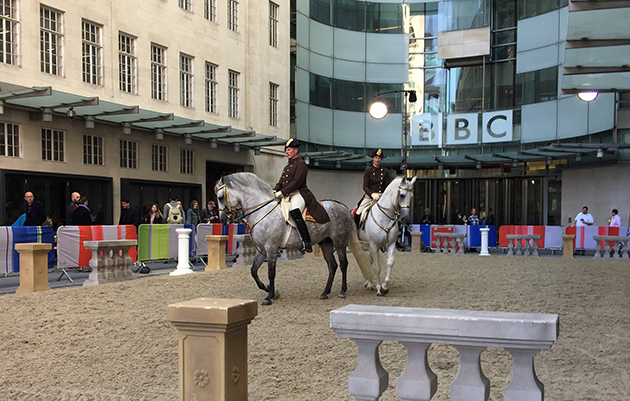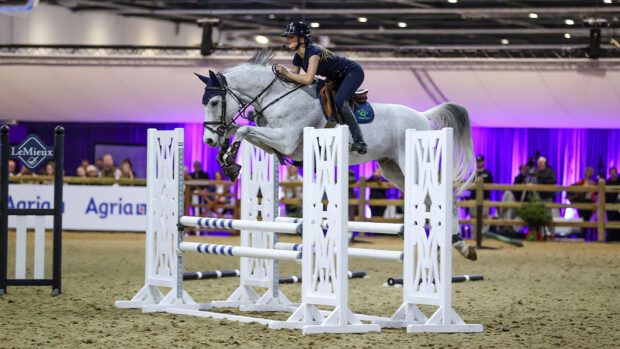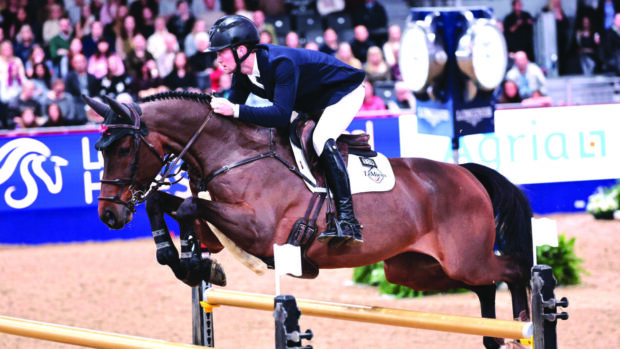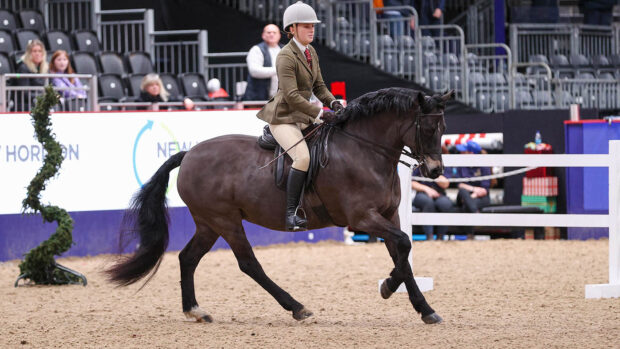What does it take to turn a grassy field or empty indoor arena into a thriving show centre, complete with stabling and foot-perfect, all-weather surfaces? H&H finds out
It’s hard to imagine what the magnificent, glass-roofed arena at Olympia looks like before it’s been equestrianised. Prior to tonnes of arena surface being laid down, the venue is more akin to a sleek ice skating rink than an international arena hosting world-class horse sport.
So what are the big factors in getting these shows set up and running like clockwork?
The surface
Anything is possible, says Martin Collins from Martin Collins Enterprises, who has been providing temporary arenas for some of the world’s largest equestrian events for more than two decades, including Horse of the Year Show (HOYS), the London International Horse Show Olympia and Global Champions Tour (GCT) shows.
“It is possible to put a temporary arena on almost any surface — it’s what is underneath that can be the biggest issue, as well as the time frame needed to install it,” he says. “Putting an arena on a big, flat, concrete, indoor arena such as Olympia or Wembley is relatively straightforward.
“If the arena is to sit on undulating grass land or an unlevel area, then a temporary levelling base needs to be made and laid to give a level start point.
“Outdoor shows may need to have drainage while indoor ones won’t.”
Every October, Birmingham’s NEC is transformed into an equestrian utopia as HOYS hosts the finale to the showing year and a high point of the domestic showjumping calendar, alongside thrills, spills and top-class entertainment.
“Logistically, the show is very complicated as it takes up over 50 acres of the NEC complex, consisting of four arenas and link ways totalling over 9,000msq,” says Becky Bolan of Andrews Bowen Ltd. “It requires 1,800 tonnes of Andrews Bowen 2012 surface delivered on 62 articulated lorries, plus four low loaders and three Andrews Bowen Prograde maintenance machines.”
Accessibility
It’s not just about the venue itself — accessibility also plays a big part.
“The right-sized transporters have to be able to get into the venues, as well as the correct-sized plant machinery to offload and reload the surface from the trucks,” Martin adds.
“Articulated lorries that carry 29 tonnes of surface are the usual method of transportation, but if venue access won’t allow for this, then smaller trucks have to be used.”
For an event such as the London GCT, which has a 5,000msq arena, 1,000 tonnes of surface is transported, which requires over 50 truck movements.
Time
“Time is also another big factor,” says Martin. “A show such as Olympia only allows us two days to install the arena, and overnight after the show to remove it, requiring a team of 10 men plus various pieces of plant machinery.”
At HOYS, the arena is installed by 20 workers over about five days. “It’s certainly a matter of all hands on deck,” says Becky.
In November 2016, the BBC’s The One Show, situated in the centre of London, played host to the Spanish Riding School (pictured above).
The producers needed a temporary surface laying outside Broadcasting House for the riders to perform live.
“With only five days’ notice, we mixed a surface, organised all the logistics, dealt with the relevant permits, security and safety issues and gave the horses of the Spanish Riding School of Vienna a foot-perfect surface,” Martin explains.
“The team had to install the surface the morning of the show with the trucks only being allowed outside the studios until 7am, so it was a 3am start. As the area was subject to weight restrictions, the trucks couldn’t tip the surface out, so it had to be wheeled in by wheelbarrow and laid by hand.”
Maintenance
Maintenance of the arena is also a key component.
“The most important aspect of surfacing design is that it provides a consistent platform for the various equestrian activities it is required for,” says Becky. “We use the Equaflow system which provides and maintains the optimum moisture content.
“The system offers up to 646,000 litres of water storage and is made up of a plastic sub-base replacement layer, with water storage and drainage unit. It also absorbs impact and reduces concussion.”
This system came in useful for the 11th round of the 2015 Longines GCT held in London at Syon Park by the River Thames.
“One of the most visited cities on the planet, London is a perfect venue for the public, but a challenge for us to turn the parkland setting into an FEI international arena,” says Becky.
“This was made possible with the Equaflow sub-base replacement system in conjunction with 1,250 tonnes of Andrews Bowen 2012 surface.”
With time at a premium, using the most efficient machinery to maintain the surface is vital.
“The mixture of wax, fibre and sand at an event such as Olympia is quite dense with little movement,” says Martin. “It is made bespoke for Olympia, as it has to accommodate all manner of disciplines, from extreme carriage driving to dressage and showjumping. There is little time between classes, so we use Martin Collins Arena Masters maintenance equipment to groom it.”
Continued below…

Double-decker stables and a hidden horse walker: is this Britain’s most compact yard?

Five-star hotel or showjumping yard? It’s hard to tell…
At first glance, it's difficult to work out
Stabling
Another vital aspect of a show is providing temporary stabling.
L H Woodhouse & Co Ltd developed the first temporary stables back in 1933. Today, they offer a range of hire stables from the luxurious Greenwich Barn stables used at the London 2012 Olympics, to their timber stables used at events across the country. Events they supply have included the World Equestrian Games, the Hickstead Derby, the Royal International Horse Show, Royal Windsor Horse Show, Windsor endurance and Euston Park.
“We work with the organiser to agree a practical and safe layout, taking into account any site specifics, such as access, ground levels, drainage, exposure to elements, provision of water, electrics, and waste removal,” says general manager Peter Cook. “We then build the stables to achieve safe access.”
All their equipment is delivered on 40ft artic lorries.
“We employ the services of a haulier and work with our clients to ensure all loads are maximised wherever possible,” says Peter. “Stable entries can fluctuate and sometimes entries are late, which can lead to late demand, so we work with clients to meet any last-minute alterations.”
The number of stables per load depends on the type of stabling used: barn, 50 per load; quickstable, 70; and timber, 100.
“We operate smaller contracts with trailer-mounted Moffett Mounty forklifts,” adds Peter. “Larger contracts would be completed with all-terrain forklifts, normally fitted with grass tyres to respect the venue’s flora and fauna.”
Arkenfield Stable Hire Ltd provide temporary stabling and buildings, such a judges boxes, to a number of equestrian events across the country, including Olympia and Royal Bath and West.
“We supply Olympia with around 200 stables that have customised full doors, plus we provide buildings that house all the stock for the trade stands,” says the company’s director Jacqueline Sutton. “These are transported in a lift up to the top floor of the show building and set out without roofs. We have also supplied huts for places to eat and drink, so we are quite versatile.”
Arkenfield also supplies American barn-style temporary stabling, perfect for the unpredictable British weather.
“People like the practicality of undercover stabling, plus it gives the show centre something more exclusive to offer people who are willing to pay extra.”
The stables are transported by vehicles and trailers.
“One load takes 50 stables,” says Jacqueline. “We take eight trailers to Olympia.”
The firm recently provided stabling for the Royal Bath and West.
“Eight of our guys worked for a week in preparation,” Jacqueline explains.
“Alongside 200 stables for the showjumping and showing horses, we also supplied separate blocks of large 10x12ft stables for the heavy horses, so around 300 in total.”
The full article about building showgrounds was first published in the 8 June issue of Horse & Hound magazine





